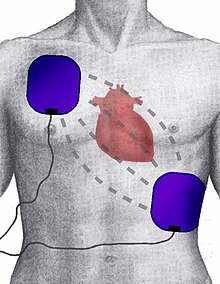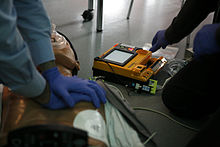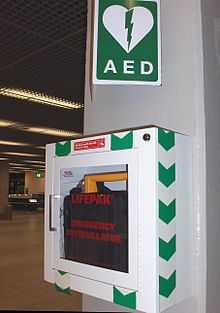Automated external defibrillator
An automated external defibrillator (AED, and Public Access Defibrillation or short Laiendefi ) is a medical device used to treat shockable cardiac arrhythmias by delivering electric shocks. In contrast to defibrillators from the rescue service or clinics , AEDs are particularly suitable for first aid by lay helpers because of their design and functionality .
Application, structure and function
In adolescents and adults, the two adhesive electrodes, also known as defibrillation electrodes or fast patches , are attached anterolaterally under the right collarbone and under the left armpit in the so-called anterior - anterior position . After applying the adhesive electrodes, software in the AED analyzes the heart rhythm . If ventricular fibrillation , ventricular tachycardia and, with some AEDs, supraventricular tachycardia are detected, defibrillation is enabled. A distinction is made between fully automatic and semi-automatic AEDs. In the fully automatic design, the device delivers the electric shock independently while constantly monitoring the shock conditions, while in the semi-automatic design the user has to press the shock button within a defined period of time. With the fully automatic design, the active pressing of the shock button is unnecessary, but there is a delay due to warning notices and there is also the risk that the patient will still be touched and a shock will be delivered without an active decision and possibly harm a first aider. The vast majority of AEDs in Germany are of the semi-automatic design.
If a non-shockable rhythm is detected or if the measured values are below the device-specific asystole limits , defibrillation is not released. Every two minutes an instruction is given not to touch the patient in order to allow a new ECG analysis and possibly a new shock.
Some AED models support the first aider with the necessary cardiopulmonary resuscitation , but to a very different extent. AEDs are now on the market that can also evaluate the quality of chest compressions through voice prompts and give instructions on potential for improvement (for example, "press harder", "press faster", "press slower", "completely relieve").
There are also variants for semi-professional use. These enable the display of an ECG lead and contain a manual defibrillation option and, if necessary, an integrated pulse oximeter . Such devices often have a "PRO" for "professional" in their name.
- Special features for children and toddlers
Not all AEDs are approved for use in children under eight years of age. Some of the approved AEDs have significantly smaller pediatric defibrillation electrodes. These are usually recognized automatically by the device and the energy output for defibrillation is reduced accordingly. A variant of other AEDs can be switched to child mode by operating a slide control or inserting a special child key. In this case, you use the existing electrodes and glue them to the chest and back - the so-called anterior-posterior position , in order to prevent the two electrodes from touching one another.
distribution

Since the chance of survival of those affected decreases by approx. 10% with every minute that passes without defibrillation, the therapy-free interval until the heart patient is cared for by the ambulance service and emergency doctor should be shortened by defibrillation as early as possible. For this reason, all well-known aid organizations have been promoting the use of AEDs in the public environment since 2001 . There are now numerous heterogeneous island projects with partially publicly accessible AEDs. These public AEDs, used as devices for public access defibrillation (PAD), can be found in airports, train stations, football stadiums and other public buildings. The AEDs are usually located in the entrance area of buildings, at porters or information desks.
In order to teach in accordance with the guidelines, in 2011 all training bodies agreed that an AED should also be presented in every first aid course . In some of Germany's neighboring countries (such as Belgium, Denmark, France, Luxembourg, the Netherlands, Switzerland and Austria) there is a tendency towards regular training on AEDs.
Legal situation
Germany
The use of an automated external defibrillator (AED) by laypeople as part of first aid is legally harmless. Basically, an AED is an active medical device , i. H. The Medical Devices Act (MPG) and the Medical Devices Operator Ordinance (MPBetreibV) are decisive for the organization of operational first aid .
- A medical device book must be kept.
- Only the manufacturer or an authorized person who acts in agreement with the manufacturer may subject the AED to a functional check at the operating site.
- A medical device representative must have been appointed by the operator and instructed in the professional operation of the product.
- AEDs are fundamentally subject to safety controls (STKs).
To 3.) The medical device representative can instruct the other operational staff. In practice, the initial training takes place in a more extensive framework for as many company first aiders as possible. In addition, in an emergency (justifying emergency; Section 34 StGB), an AED may also be used on the patient by untrained staff.
4.) A draft of the Federal Ministry of Health to amend the MPBetreibV of December 7, 2015 provided in § 10 paragraph 2 (draft) that AEDs in so-called "public space" (at train stations, airports, etc.) should be subject to a safety check can be omitted if the AED is self-testing and a regular visual inspection is carried out by the operator. This legal change came into force on January 1, 2017.
It is advisable to follow the signs for the fire extinguishers. For AED owners whose employees are insured with the employers' liability insurance association , there is an annual instruction obligation.
Other European countries
- Belgium : The Royal Decree of April 21, 2007 regulates the use of automated external defibrillators of category 1 and 2. Category 1 AEDs can be used by professionals and by everyone.
- France : Decree n ° 2007-705 of May 4th 2007 allows anyone, including non-medical professionals, to use an AED.
- United Kingdom : The United Kingdom also regulates the use of the AED by law. More than 600 defibrillators hang in busy public places.
- Luxembourg : The use of an AED has been regulated by law since November 19, 2008. AEDs can now be installed in public buildings and places and used by everyone.
- Monaco : There are over 80 defibrillators in public places in the principality.
- Netherlands : Everyone is entitled to operate an AED.
literature
- Martin Gruner: Early Defibrillation . Stumpf + Kossendey Verlag, Edewecht 2006, ISBN 3-938179-33-3 .
- GRC Guidelines on Basic Life-Saving Measures for Adults and AED Use. Here various PDF documents on the topic
- DGUV information on automated defibrillation as part of operational first aid (pdf)
- Directive 93/42 / EEC on medical devices and their classification (ANNEX IX) in the consolidated version of October 11, 2007
Web links
- definetz eV - non-profit association with what is currently the largest cadastre for defibrillators in Germany
- Via medici online article: Automated defibrillators for first aiders and laypeople?
- Defi locations in Austria




